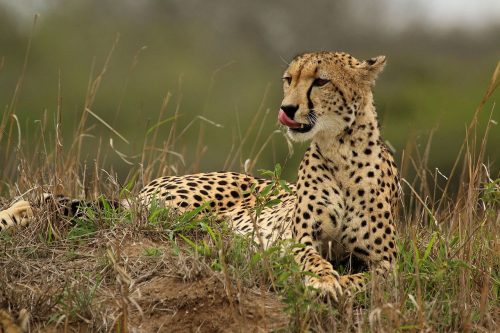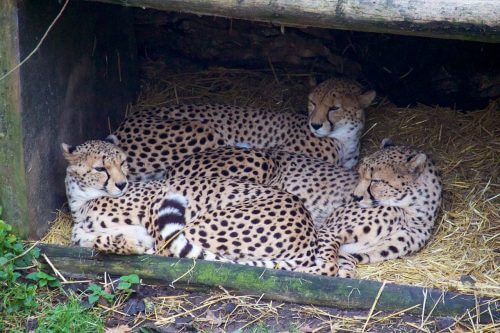Continued to the previous list About the extinction of the carnivores, below is a detailed reference to one of the carnivore species, which, despite being well-known and well-loved, is in a sad state.

Cheetahs have always been "pets" of kings, counts and the like. In ancient Egypt, Rome and the East, cheetahs were raised in the courtyards of the rulers. Even today there are those who keep cheetahs as "pets" or as hunting aids. This is the case in Saudi Arabia and the Gulf countries, which are increasing the demand for cheetahs from the wild, an activity and tradition that is one of the reasons for their extinction.
Nowadays, the rate of extinction is increasing due to wild hunting and mainly due to the fragmentation of the cheetahs' living areas, which causes poverty in the genetic diversity of separate populations and of course fragmentation which causes a reduction in the cheetahs' living and hunting spaces. Today there are many zoos and ventures in which endangered animals are bred with the aim of preserving the species and in many cases to release individuals into the wild and raise up damaged populations.
In many cases these projects are successful, such as the repatriation of rams and wild animals with us, but in the case of carnivores in general and cheetahs in particular, a serious problem arises.
In the mid-nineties I was a participant in a course on cheetah conservation, at the University of Pretoria, in the course the questions and problems of breeding cheetahs in captivity came up, and the issue came up and the questions remained unsolved.
Funding by the National Zoological Gardens of South Africa, the University of Pretoria and North-West enabled Dr. Adrian Tordiffe to investigate the issue and come up with a number of answers and solutions:
Between 1829 and 1952, 139 cheetahs were captured and exhibited in 47 zoos, most of them - 115 survived less than a year, and not a single cheetah escaped. Despite a considerable improvement in the conditions of holding and treatment in zoos and elsewhere, the cheetahs continued to suffer from diseases that rarely occur among other predators in captivity or among cheetahs in the wild. In the post-mortem examinations, kidney disease, inflammation of the alimentary tract, liver damage, thickening of the heart muscle and nerve damage were identified.
Because of their poor condition in the wild, every cheetah that dies in captivity is a severe blow to the species, as their numbers continue to decrease. In 1975, about 10,000 individuals were counted, while today there are only about 7,000. A situation that requires change when one option is return from captivity. That's why the study was conducted.
In 1980, some suggested that one of the reasons for mortality in captivity is low genetic diversity due to breeding among relatives, but it turns out that the genetic diversity in cheetahs in captivity or in the wild is similar, so this factor is ruled out. Other factors such as strain and lack of physical exercise were also ruled out. Recently, the focus has been directed to the food given to cheetahs in captivity (See this article):
Cheetahs in the wild feed mainly on small antelope species, the hunter is eaten almost entirely, including skin, bones and facial parts. Cheetahs in captivity are fed mainly meat and a few bones of farm animals. Muscular parts of cattle, sheep, chickens, etc. The tests revealed that when the cheetahs were given whole carcasses and their excrement was examined, an improvement in the composition of the fatty acids and a decrease in toxins in the intestine was seen, but feeding cheetahs in captivity with whole carcasses is an expensive way.

It turns out that in order to prevent death and disease it is necessary to understand the metabolism of cheetahs, since when some of the metabolic processes are not "normal" diseases are caused, Dr. Adrian turned to the study of metabolism at a molecular level to identify molecules in urine and feces in an attempt to distinguish the differences between cheetahs in captivity and those in the wild.
Concentrations of hundreds of amino acids, fatty acids, sugars and more were measured, it turned out that the concentrations of fatty acids in cheetahs in captivity were much higher than those of cheetahs in the wild, blood tests also found high concentrations of fatty acids that are "linked" to a wide variety of diseases and negative procedures.
Dr. Adrian points out three reasons for the high concentration. The first reason is the fact that cheetahs in the wild eat small antelopes whose bodies have a high concentration of saturated fats and a low concentration of fatty acids. Cheetahs in captivity eat meat from farm animals that contains a high concentration of fatty acids. The second reason: the digestive organs and fat eaten by cheetahs in the wild contain high concentrations of fatty acids compared to saturated fat in the meat given to cheetahs in the wild and finally, cheetahs in the wild eat less often than their captive brothers who are fed every day. During fasting, the body utilizes the fatty acids stored in the body to produce energy and thus lower the concentration to low levels.
Dr. Adrian says that fatty acids are easily oxidized compared to saturated fat and it is possible that cheetahs do not have natural data to prevent oxidation and prevent the damage caused by oxidized fatty acids, which causes poor health.
Later, concentrations of organic acids in urine were tested and compared, organic acids are the end product of breaking down amino acids, sugar and fatty acids. It was found that the cheetahs secreted phenolic acid components that are formed when undigested proteins reach the large intestine. Bacteria change amino acids from these proteins into toxins that are absorbed into the bloodstream or excreted in the urine or reach the liver where they are neutralized and excreted. Studies have shown that this process is problematic since phenolic acid has a negative effect on the production of dopamine, the hormone that is important for the activity of the intestines and kidneys (See this article).
It was also found that cheetahs use a chemical procedure called glycine conjugation to neutralize the toxicity of phenolic acid. In captive cheetahs that only feed on meat, the concentration of glycine is low compared to their brothers in the wild who also eat bones, cartilage and skin, therefore in captive cheetahs when the need for glycine to neutralize toxins increases, a lack of amino acids is created. Glycine is important for several physical activities and therefore its deficiency causes poor health.
Dr. Adrian concludes in his article that: "Although the research did not provide all the answers, it focuses attention and opens a way for future research that will provide guidelines for feeding cheetahs in captivity."
I will add that: in the early seventies, Giora Ilani proposed returning cheetahs to the Great Rivers Reserve in the Negev, the idea was to capture cheetahs in Iran and after a stay in the fence in the Negev to release them. An idea was dropped due to financial cost and fear of "clashes" between the cheetahs and Bedouin shepherds, later relations with Iran deteriorated and the idea was finally canceled... too bad...
See more on the subject on the science website:

5 תגובות
Heartache my favorite animal!
People believe that if humanity works for wild animals it will save itself is a slogan.
The truth is that if this is not done we will be remembered as a species that lived a million years and that's it. The dinosaurs lived about 65 million years in my memory.
The human race exterminated all the sub-races of Homo that shared the same area with it: Neanderthal (although very partially assimilated into us) and there was a race with a bigger brain than ours that became extinct. And Homo erectus and everything up to the chimpanzee - there it was less of a danger to us. I saw that an elephant's brain is about 3 times bigger than ours, although the brain cells are also bigger, which means a different type of intelligence. Some elephant researchers believe that elephants think a lot when they look at us. They are not just staring.
The technologies are moving towards the release of energy from fuels and food production in limited areas. This is possible in the field of treatment in places where people sit.
No consideration for animals.
Species that were formidable, a lion is a really big animal. We ruined their lives.
Scientists predict that at the current rate of pollution within 100 years the temperature will be so high that the atmosphere will begin to leak.
In addition, a culture that throws away about 50% of food as waste, as well as non-biodegradable equipment. Although with proper planning it is possible to salvage and recycle about 80% of the waste, without going crazy.
Even if it is excessive, it is already difficult to spend the summer without an air conditioner in terms of heat tolerance. In the past, air conditioning was not needed.
And as I often write: the time has come that instead of controlling the human population for the sake of the environment, there should be control of the environment for the sake of the human population.
sad. One of my favorite animals.